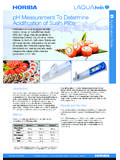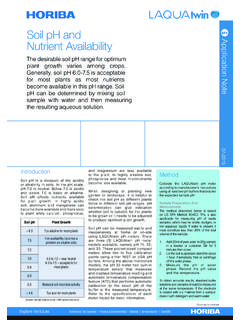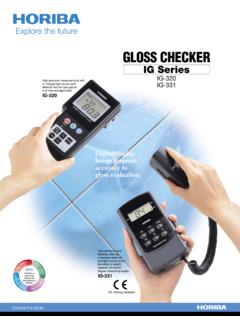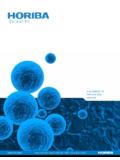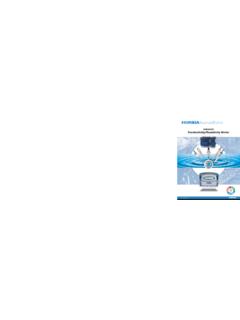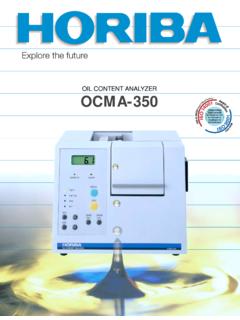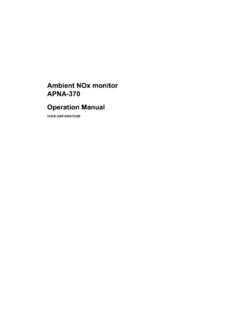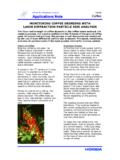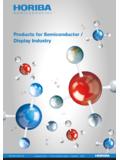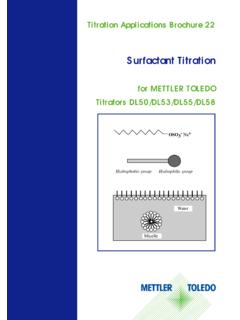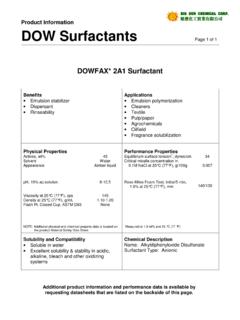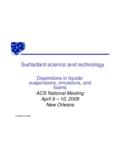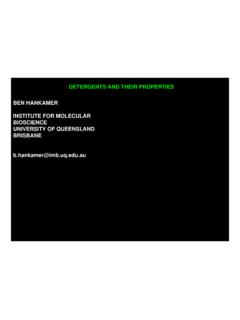Transcription of Dispersing Powders in Liquid Webinar 2013.ppt - …
1 2013 HORIBA, Ltd. All rights Powders in LiquidMark 2013 HORIBA, Ltd. All rights Typical powder : individual particles and clumps stuck together by weak or strong forces Agglomerates: assemblage of particles which are loosely coherent Aggregates: assemblage of particles rigidly joined together Well dispersed: individual particle state 2013 HORIBA, Ltd. All rights reserved. Powders When measuring powder as suspension Choose solvent (avoid dissolution) Wet powder (surfactant) Dispersing aid to avoid re-agglomeration Energy to break agglomerates into primary particles Pump & stirrer or ultrasoundDispersion Strategies 2013 HORIBA, Ltd.
2 All rights for Wetting Sprinkle particles on of target dispersant. If the particles float on top and do not penetrate the water surface, they are not wetted. This is usually a bad sign. If the particles break through surface and sink, they are a) wetted or b) so big that gravity is more important than surface tension. If it is case a, you are in floating on topPlume of sinking particles 2013 HORIBA, Ltd. All rights reserved. Drop of a Liquid on a solidSmall (philic)Large(phobic) Measurement of Contact Angle ( ) The contact angle is a measure of how well the Liquid drop adheres to the surface of a solid Large angles indicate poor wetting ability.
3 Small angles indicate good wetting ability. Surfactants reduce surface tension and thereby are conducive to good wetting. (Instruments are available for measuring contact angle)Particle Wetting 2013 HORIBA, Ltd. All rights Reduces Surface Tension Non-polar surfaces (hydrophobic) have low surface energy, need surfactant in aqueous phase to aid wetting Surfactant lowers surface tension from ~70 to 30 mN/m Slight decrease, linear decrease, then becomes constant at CMClog C (mN/m)70 CMCsurfactantmicelle 2013 HORIBA, Ltd. All rights reserved. Surface tension must be lowered so Liquid will adhere to particles.
4 + + + + + + + + + ParticleLiquidGoal is to completely coat particle with Liquid Small Contact Angle = Good WettingParticle WettingLarge Contact Angle = Bad Wetting 2013 HORIBA, Ltd. All rights of Surfactant Addition Surfactant addition will disperse particles for good measurement Particle size first decreases Reaches minimum @ proper concentration Add too much: particle size increases - agglomeration Common concentration: Particle SizeSurfactant Concentrationstart perfect too much 2013 HORIBA, Ltd. All rights hydrocarbonPolar ionic dipoleEquilibrium established between surfactant on particles and surfactant in solution Surfactant Mechanism 2013 HORIBA, Ltd.
5 All rights reserved. As more surfactant is added, equilibrium shifts. Surfactant leaves surfaces to start formation of micelles. This is called the Critical Micelle Concentration (CMC). Particle surfaces are no longer repulsed, and energy of the system favors reagglomeration-----------+++++++++++-Mi celles+ Cationic Surface- Anionic Surfactant+Critical Micelle Concentration 2013 HORIBA, Ltd. All rights surfactant -agglomerated particlesExcess surfactant-reagglomeration of particlesOptimum concentration proper particle dispersionEffect of Surfactant Addition 2013 HORIBA, Ltd.
6 All rights of Surfactants H-C chain is hydrophobic Polar head is hydrophilic Nonionic Anionic Cationic Zwitterionic 2013 HORIBA, Ltd. All rights of Surfactants Igepal, nonionic Triton X-100, nonionic Aerosol OT, anionic Trimethylhexadecyl ammonium chloride,cationic 2013 HORIBA, Ltd. All rights reserved. Nonionic surfactants adsorb to charged and neutral surfaces, create steric barrier Igepal CA630 Ethoxylated octyl phenol Nonionic Triton X100 Octylphenoxypolyethoxy ethanolNonionic Tween 20 Polyoxyethylene sorbitanNonionic Aerosol-OT Dioctyl ester Na Sulfo succinic acid Anionic Cationic surfactants often used for biological samples, strongly bonds to negatively charged surfacesHydrophobic surfacePolar groups orient to aqueous phaseAnionic surfactantpolar headnon-polar chainCommon Surfactants 2013 HORIBA, Ltd.
7 All rights Solvents Working with aqueous systems is usually easier for many reasons. But don t forget to try a less polar solvent such as isopropyl alcohol. And, don t forget that organic solvents are more difficult to handle due to fire and health hazards. 2013 HORIBA, Ltd. All rights for Answers Check the literature and the web and see what other people use. Google to get the idea to use MEK with lead. 2013 HORIBA, Ltd. All rights Try a series of options. Here is a series of suspensions and check them by eye, then measure. 2013 HORIBA, Ltd.
8 All rights 14887 Provides rigorous approach to dispersion Need to understand powder properties and ionic strength in suspension Match powder to Liquid to Liquid , dispersant, and conditions 2013 HORIBA, Ltd. All rights the powder Does your powder best fit into the following categories Metal Metal oxide Ionic salt H-bonding organic Non-polar organic Weakly polar Organic amine Fluorocarbon 2013 HORIBA, Ltd. All rights the Liquid Possible Liquid categories include: Water Non-polar Weakly polar Highly polar H-bonding organic 2013 HORIBA, Ltd.
9 All rights Dispersant* Consider possible dispersants Copolymer Organic: acids, amines, esters, phosphate, sulfate, sulfonate Phospholipid Polyester Polyionic salt*will discuss later 2013 HORIBA, Ltd. All rights it All TogetherAvoidIEP 2013 HORIBA, Ltd. All rights it All TogetherSummaryPersonal experience: prefer electrostatic stabilizationand avoid use of polymers 2013 HORIBA, Ltd. All rights particles approach close enough to cross the potential barrier (when attractive forces exceed repulsive forces), they come together (agglomerate).
10 Goal: repulsive forces strong enough to keep particles apart, even during close approach. Can be accomplished by surfactant coating of particle Forces(Van der Waals)Repulsive Forces(Charge)Repulsive Forces(Charge)CHARGECHARGE++++++++++++Di spersants: Particle Interactions 2013 HORIBA, Ltd. All rights Potential Energy VTDistance Between Surfaces0VT= VA+ VRVAA ttractionRepulsionVRPotential Energy Stability depends on balance of forces. Attractive due to Van der Waals, & repulsive due to electrical double layersaround particles. If VTlower than average thermal energy, KT, then high probability two adjacent particles will eventually collide & remain attached due to strong Van der Waals forces at very close forces cause particles to remain of InteractionInteraction of Two Charges Surfaces/ParticlesVan der Waals forces cause particles to come together.
